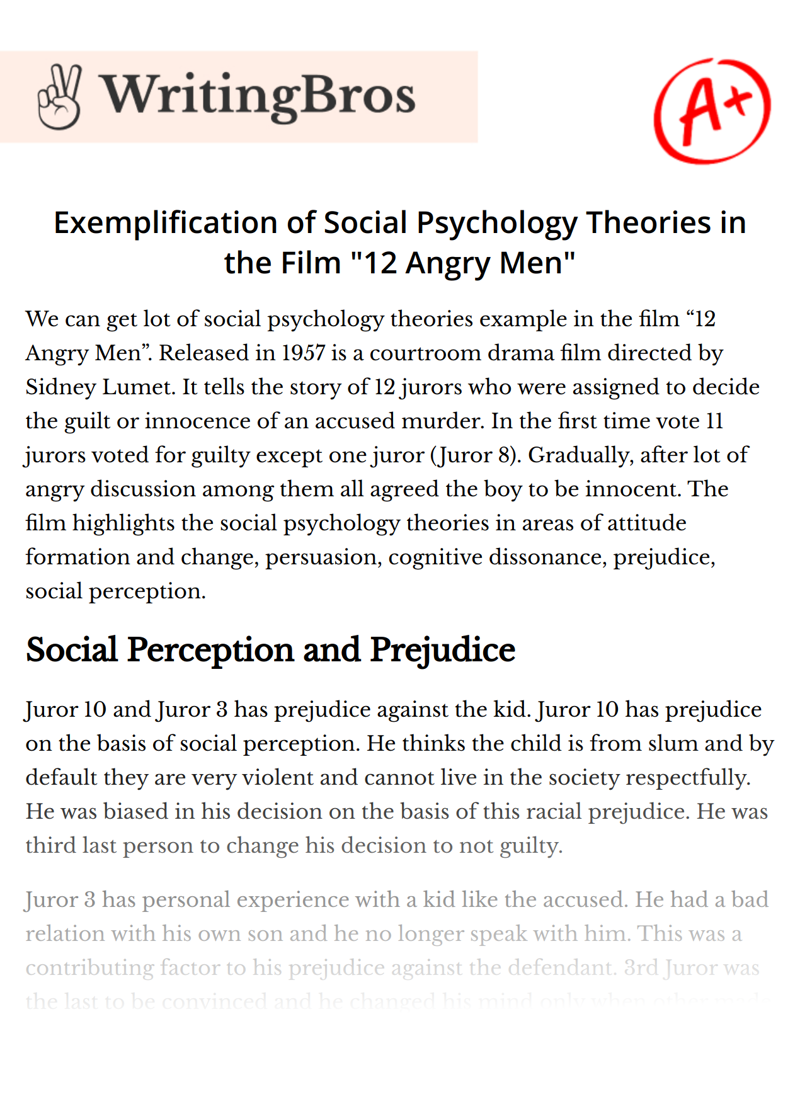Exemplification of Social Psychology Theories in the Film "12 Angry Men"

Table of contents
We can get lot of social psychology theories example in the film “12 Angry Men”. Released in 1957 is a courtroom drama film directed by Sidney Lumet. It tells the story of 12 jurors who were assigned to decide the guilt or innocence of an accused murder. In the first time vote 11 jurors voted for guilty except one juror (Juror 8). Gradually, after lot of angry discussion among them all agreed the boy to be innocent. The film highlights the social psychology theories in areas of attitude formation and change, persuasion, cognitive dissonance, prejudice, social perception.
Social Perception and Prejudice
Juror 10 and Juror 3 has prejudice against the kid. Juror 10 has prejudice on the basis of social perception. He thinks the child is from slum and by default they are very violent and cannot live in the society respectfully. He was biased in his decision on the basis of this racial prejudice. He was third last person to change his decision to not guilty.
Juror 3 has personal experience with a kid like the accused. He had a bad relation with his own son and he no longer speak with him. This was a contributing factor to his prejudice against the defendant. 3rd Juror was the last to be convinced and he changed his mind only when other made him realized of his projected feelings of his son onto the defendant.
Controlled and Automated processing
We can relate the movie discussion to our class discussion on scenario of violent crime in which Larry a school dropout shoots the policeman while coming out from liquor store. So, there can be motivational theories, learning theories or cognitive theories in the case of boy who was accused guilty of murdering his father. However initially the Jurors didn’t considered all these facts and 11 of them voted guilty. Here we can say that the modes of social thought were automatic processing. The Jurors thought in in a fast, relatively effortless, and intuitive manner. Juror 8 however thought in controlled process way. He analyzed each every juror thought and systematically and logically in a very effortful manner, he discussed the relevance of the witness testimony and disproves them all.
Informational Social Influence
There was also initially informational social influence. This had much worst effect on addition of time constraint. One jury had to attend ball game in the evening and he just wanted this to be over. Other jury who was businessman had some important meeting of him. One Juror only relied on other’s judgement. Majority influence played role in his decisions. He thought the society’s or majority’s group decision to be correct and changed his decision quickly as the majority changed from guilty to not guilty.
Attitude formation and Persuasion
Persuasion played a central role in the plot of “12 Angry Men”. According to social psychologists Richard Petty and John Cacioppo, there are two routes to persuasion: peripheral and central which are applicable here.
The central route to persuasion is the process by which a person thinks carefully about a communication and is influenced by the power of argument. We see the 8th Juror persuaded the other juror in a well-thought, elucidated manner. Juror 9 supported the Juror 8 on the basis of Juror’s passion and sense of justice. Lastly, a foreign juror appeals to the central route to persuasion when he advocates, “going deeper,” in reference to an examination of the facts. The peripheral route of persuasion is characterized by superficial cues surrounding the argument rather than the argument’s factual validity. This was used by 10th Jury giving prejudice and racist reason to support his decision and to persuade other.
Theory of attribution
Jones and Davis’s (1965) theory of correspondent inference says how we use information about others’ behavior as a basis for inferring their traits. Like jury who lived below the defendant house, said that in past the boy had tried to slash another teenager with knife, had an argument with his father and threatened his father to kill him. All these behavior made us to infer boy’s trait to impulsive and angry person who can murder someone. There were biases in attribution.
Cite this Essay
To export a reference to this article please select a referencing style below

